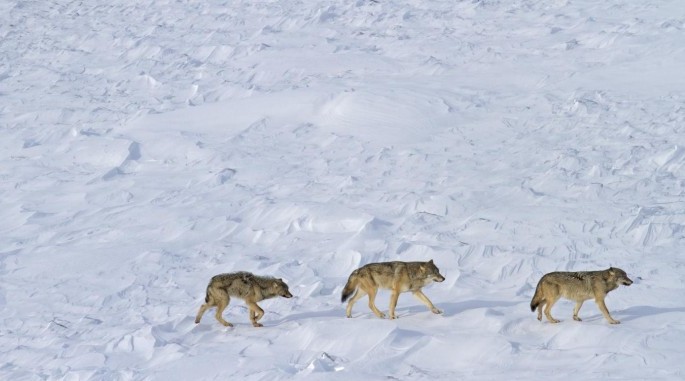Wolves are pack animals, yet on the Isle of Royale National Park (located in Lake Superior) only three wolves remain. Researchers from Michigan Technological University observed the wolves during the annual Winter Study, and the lone trio appears to be all that is left of the nine Isle Royale wolves seen last winter.
The park offers outstanding possibilities for research in a remote ecosystem, and the annual report of the Ecological Study of Wolves on Isle Royale, released today, marks the project’s 57th year of observing Isle Royale wolves and moose. It is the longest running study of large mammal predators and prey on Earth. This year, along with the three resident wolves, scientists counted 1,250 moose on the island and observed two visiting wolves that came and went across an ice bridge to the mainland.
Isle Royale wolves play an important role in the ecosystem, by keeping the number of herbivores, such as moose, from rising too high and wiping out the plant life. “It’s not the presence of wolves that matters so much, it’s whether wolves are performing their ecological function,” explains John Vucetich, an associate professor of wildlife ecology who leads the study along with Rolf Peterson, a research professor at Michigan Tech.
Can the Isle Royale Wolves Recover?
To understand Isle Royale wolves, we have to understand their genetics. Inbreeding has greatly affected the packs over the past half century, which is clear with the three remaining wolves.
With only three wolves remaining on the island, recovery of the wolf population is unlikely because there just isn’t enough genetic diversity left. According to Vucetich, “There is now a good chance that it is too late to conduct genetic rescue.”
The small pack is made up of two adults and one nine-month-old pup. But unlike its pack mates, the pup does not appear healthy. It has a constricted waistline, hunched posture and seems to have a deformed tail, the researchers say.
“Those observations suggest that the pup is not well off,” Vucetich says, noting that on the last day of the study, Peterson had found the two adult wolves, but not the pup. “It would not be surprising if the pup was dead a year from today.”
Even if the pup were healthy, there would not be enough genetic diversity in the Isle Royale wolves. In the case of wolves, three is not a crowd. The wolves’ numbers started plummeting in 2009, declining by 88 percent. Vucetich and Peterson think the population decline is a result of inbreeding. All geneticists who have studied the current situation agree that recovery is unlikely without new genetic material.
Visiting Wolves
Previously, ice bridges allowed more wolves with new genetic material to make their own way to Isle Royale each winter. As the climate changes, however, the ice bridges are less frequent, so fewer wolves are visiting the island.
Looking for wolves in winter is challenging, Vucetich says, describing how he spends hours looking out a small plane window, searching for tracks or subtle signs. One day this winter the work paid off when he spotted a pair of visiting wolves asleep on a ridge.
“I could see these two wolves, they were on top of a ridge, curled up in tight little balls,” Vucetich says. “And wolves can sleep for quite some time, so we circled for a bit and decided to come back later.”
When Vucetich and the pilot returned the wolves had trotted off. But based on the tracks, Vucetich says it was easy to guess the wolves’ travel route, and they found the wolves walking along the shoreline soon after.
One wolf was light-colored, which is uncharacteristic of Isle Royale wolves. The other wore a radio collar. They were visitors who had crossed an ice bridge from the US-Canadian mainland, where the Grand Portage Band of Lake Superior Chippewa had collared the wolf.
The visiting wolves didn’t stay long on the island. Within a week the wolves left, traveling back across the ice bridge.
“Everyone wants to know: What does this mean?” Vucetich says. The answer is unclear, despite the fact that visiting wolves raise hopes for saving the population.
The remaining two options, the researchers say, are to reintroduce wolves to the island or do nothing and see what happens naturally. “One must use the word, ‘naturally’, carefully these days,” Peterson advises. “The human imprint is written all over the dynamics of this wolf population in recent decades.”
And what to Do with All the Moose?
Along with Isle Royale wolves, the other iconic animal on the island is the moose. In spite of several harsh winters, the moose population has been growing annually at 22 percent for each of the past four years. “If that was money in the bank, you’d get rich in a hurry,” Vucetich says. “Soon we’ll be moose rich.”
While iconic, a proliferation of moose could be a problem. “At that time the moose population had considerable impact on forest vegetation,” Vucetich and Peterson write in the Winter Study annual report. “Concerns remain that the upcoming increase in moose abundance will result in long-term damage to the health of Isle Royale’s vegetation.”
The balance of predator-prey on Isle Royale has clearly tipped, and it is not yet clear what actions humans will or will not take. To keep in touch with Isle Royale National Park, learn more about the Isle Royale wolves, or see the latest cultural resource management plan, visit the United States National Park Service website.
Located in Michigan’s Upper Peninsula, Isle Royale National Park is near the southern border of Canada, the eastern border of Minnesota, and the northeastern border of Wisconsin.
Photo courtesy of Rolf Peterson

